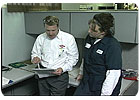
Although advancements in the dairy industry have helped defeat some of the threats to foodborne illness, food safety remains an important issue for dairy processors. Grade A facilities voluntarily implement HACCP (Hazard Analysis Critical Control Point) programs and Good Manufacturing Practices to ensure the safety of their products to customers and end-consumers. That said, successful third-party audits are one of the best ways facilities can demonstrate their commitment to food safety.
Auditors review pest management as a distinct component of an inspection, accounting for as much as 20 % of the total audit score. Year round preparation is critical for food-safety audits, especially for the pest management section.

Ongoing Preparation
An ongoing Integrated Pest Management (IPM) program will help ensure that any pest infestations are managed effectively before the auditor comes to visit. A good IPM program starts with open communication between facility management and the pest management professional. Since minor operational changes can affect pest presence, pay attention to interior and exterior plant renovations, modifications to employee entrances, and changes to suppliers and shipments. Meet monthly or quarterly with your professional for in-depth discussions of the current pest control program, as well as any facility management updates.After implementing a system to continually adapt and improve the pest management program, the next step is to maintain accurate pest control documentation records. Key documents include service reports indicating actionable items for both the pest control provider and plant operations manager, lists of approved pesticides and detailed records on when and how they were used, trap layout maps, pest activity reports and trend data, and applicator licenses.
Keep your past service records on-site in a central logbook where the pest management professional can update them after each visit. To an auditor, complete and up-to-date documentation is a tangible example that the plant is under constant watch for pest activity and shows that pest infestations are dealt with in a timely and appropriate manner.
Pre-Audit Preparation
If audits are scheduled in advance, the facility should undergo more intense preparation at least one week prior to the inspection. One of the best ways to be prepared is to research the auditing body. Audit requirements differ from one auditing company to the next, so it's important to make sure that the pest management program meets that specific auditor's conditions. Prior to the audit, accompany your pest management professional on the weekly inspection of the plant to examine the facility's compliance with the auditing guidelines. All aspects of the pest management program, from placement of pest control devices to storage of on-site chemicals, play a role during the inspection. The auditor will review both the interior and exterior of the facility, so if rodent bait stations are placed along the fence line, even they must be properly positioned and meet Environmental Protection Agency requirements.Ongoing audit preparation is important, but don't discount the day before the audit as a chance for a last-minute review. Make sure there is no evidence of pest activity on the interior or exterior of the facility, the interior is clean, the exterior is litter-free, and all pest control documentation is on-site.
With a thorough IPM program and ongoing preparation, your facility can be ready for every audit - whether it's announced or unannounced. Being able to show customers an excellent audit score will keep them coming back for more and make all the preparation well worth it.
For a free checklist to help you prepare your pest management program for your next audit, visit Orkin University Online atwww.orkincommercial.com.
